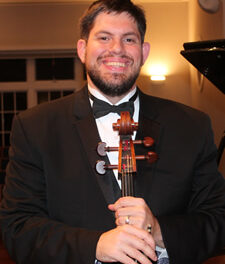This year is the 250th anniversary of the birth of Wolfgang Amadeus Mozart and most concert series are taking full advantage, drawing upon both well-known and obscure or seldom-played pieces from his catalog. The third program of the North Carolina School of the Arts’ Mozart’s Birthday Festival drew from the latter two categories. Faculty and student performers were featured in a January 24 concert given in Watson Hall.
Mozart was only eight years old when he composed the Sonata No. 5 in C, K.14, for harpsichord, violin (or flute), and cello. Esther Waite chose to play the alternative flute version with Ying-Chien Lin taking the keyboard part, using a modern Steinway with its lid low on the short stick. Despite the composer’s reputed dislike for the flute, he composed some solid works for it. This eight-minute sonata is pleasing juvenilia with pleasant themes, nicely decorated, but with rather too much repetition. More than once I recalled the negative of a half century of critics: “Porcelain-figurine Mozart.” Waite’s intonation was fine as she nimbly fingered fast passages, phrasing with good style. Lin was as attentive as a hawk, in lock step with Waite’s every turn and scaling her dynamics so as never to cover the flute. Both reflected their abilities as advanced students.
The flute sonata was merely the appetizer for the main entrée, Mozart’s Divertimento (String Trio) in E-flat, K.563. This consummate work is highly esteemed but seldom performed, in part (a musician told me) because of its length and in part because of its hybrid nature. It is not a true divertimento, court background music. Some writers also describe it as “not a doughty piece of chamber music,” a view I do not share. It was written only a few weeks after the late symphonies and it ought to be ranked next to the best late quartets and quintets. At the heart of the piece is scoring for viola, a favorite string instrument of Mozart, who often played it in chamber music concerts. The music is pretty evenly divided among the violin, viola, and cello. This six-movement trio is the composer’s longest work for chamber ensemble, lasting for nearly an hour if all the repeats are taken. Half the time is taken up by the first two movements, a lively Allegro with a simple theme and – the heart of the score – a deeply-moving Adagio. An informal Minuet and a more formal one with two trios sandwich an Andante, a lovely set of variations. A bubbly Allegro brings the wok to a sunny close. (Musical details of the trio are available at http://www.portifex.com/BArts/K563.htm.)
Length is not the only check on more frequent programming of K.563. Mozart makes considerable technical demands for all three strings. Three members of the NCSA faculty, all chamber musicians of long experience, readily met every challenge. Violinist Joseph Genualdi, an NCSA alumnus, may be remembered by Triangle music lovers as a founding member of the Muir String Quartet. Internationally renowned violist Ulrich Eichenauer, a former principal of the Dresden Philharmonic and a former member of the Mendelssohn String Quartet, is on the faculty of several conservatories. Israeli cellist Zvi Plesser has had wide experience in orchestras and chamber ensembles. All three played with immaculate intonation and made the maximum use of nuances of color, tone, and dynamics. Mozart’s complex interplay is a source of endless delight, and all three made the knife-edge changes seem both effortless and seamless. K.563 ought to be on every music lover’s list of desert island music.












